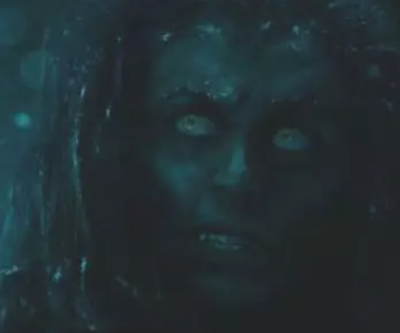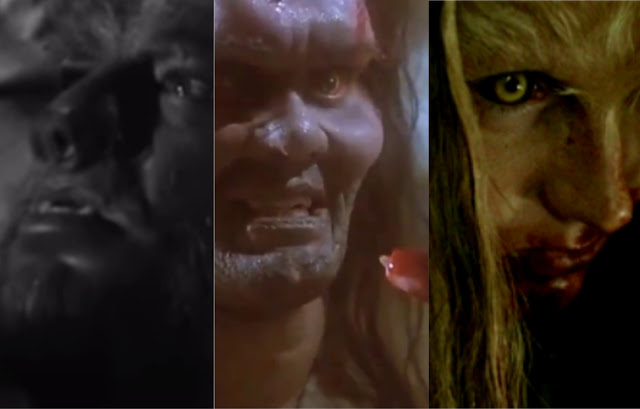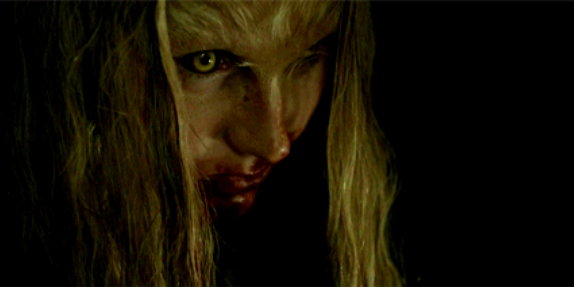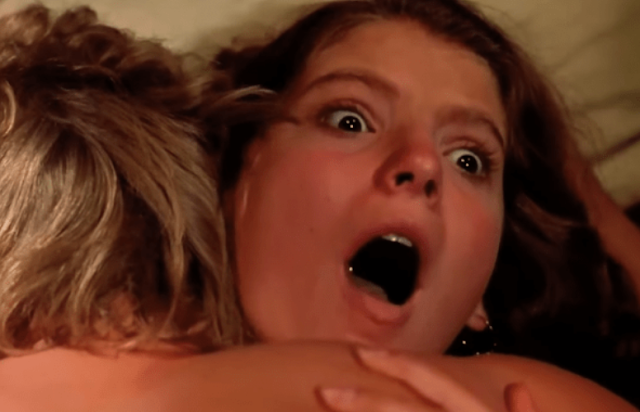Evolution of the werewolf transformation - 1935 to 2018
As your werewolf movie approaches its climax, it's time for your cursed antihero to writhe and groan as some FX magic happens and a helpless victim just stands there and watches the whole thing.
But just how the transformation occurs has changed a fair bit over the years - depending both on the evolution of practical effects and prevailing cultural trends. Some have aged better than others.
Let's start with:
The hairy crossfade (pre-1980s)
Notable examples: Werewolf of London (1935), The Wolf Man (1941), Frankenstein Meets The Wolf Man (1943), Curse of the Werewolf (1961)
Werewolves had it easy pre-Rick Baker. Come the full moon, they would segue into vicious beasts via a series of crossfades, minus the whole screaming, flesh crunching and skin ripping which would come later.
In these early films, strategic pillar walking was a less time-consuming FX option, as evidenced by this clip from Werewolf of London. In The Wolf Man, Lon Chaney's only on-screen man-to-wolf metamorphosis is a strictly feet only affair, as if it was shot for a Quentin Tarantino movie. His feet, already pretty hairy to start with, transform into giant paws, which were actually rubber boots.
In these early films, strategic pillar walking was a less time-consuming FX option, as evidenced by this clip from Werewolf of London. In The Wolf Man, Lon Chaney's only on-screen man-to-wolf metamorphosis is a strictly feet only affair, as if it was shot for a Quentin Tarantino movie. His feet, already pretty hairy to start with, transform into giant paws, which were actually rubber boots.
This sequence, in my view, is more effective than later films which would show facial transformations and leaned heavier on the crossfade. To achieve this, actors were required to stay incredibly still as make-up was applied gradually.
Interestingly, these early transformations didn't require a victim to just stand there for several minutes as the transformation progressed in front of them. That old chesnut came later.
Flesh bubbling (1980s)
With the advent of practical effects, turning into a werewolf became a whole lot more painful. Here we get the crunchy, drawn-out grueller poor old David Naughton had to contend with in American Werewolf and whatever madness is going on in The Company of Wolves.
Undeniably though, the best subset of 80s lyncanthrope transformations is the craze for flesh bubbling kicked off by The Howling - making the characters' skin look like a thick broth on the boil.
Rob Bottin used air bladders - latex balloons (or sometimes condoms) hidden underneath skin prosphetics - to depict the gnarly transformation of Eddie (Robert Picardo). Unlike almost every other werewolf, he seems to be kind of enjoying himself. Bit weird.
This technique was taken to hilarious excess in The Beast Within the following year - although it's debatable if this is actually a werewolf movie since who knows what the hell Michael (Paul Clemens) turns into.
Air bladders - after enjoying a moment in movies such as Scanners (1981) and Demons (1985) - quickly went out of fashion.
Air bladders - after enjoying a moment in movies such as Scanners (1981) and Demons (1985) - quickly went out of fashion.
CGI monstrosities (1990s-2000s)
Notable example: Bad Moon (1996), An American Werewolf in Paris (1997), Cursed (2005), The Wolfman (2010)
After the golden age of werewolf flicks in the 80s, things regressed with the advent of CGI. It was now on-trend for werewolves to look like figures from badly rendered video games.
Despite the Bad Moon werewolf boasting a full body costume and animatronic head, director Eric Red used early CGI as an assist for the transformation scene. The result is bizarre - a throwback to the hairy crossfade, but somehow worse. Red, clearly full of regret, excised the scene entirely in his director's cut.
This wasn't as bad as what went down in Wes Craven's Cursed, a movie with a troubled production that almost had American Werewolf's Rick Baker for wolfy fun times. He left the project and was replaced by KNB EFX, who gifted us with one of the worst werewolf transformations in history. The fact Judy Greer's Joanie becomes completely bald mid-transformation is just wild.
By 2010 you would think the movie industry would have learned from its mistakes, but no! That year's Wolfman reboot had Rick Baker onboard, but for reasons best known to itself opted for an embarassing CGI-based transformation scene instead.
Baker told IndieWire: "The whole transformation was done on computers, but it was based a lot on ideas I had and sculptures that I did. But I was kind of pushed out of that, and I’m still kind of stinging about it."
Skin ripping (2000s onwards)
Notable examples: Van Helsing (2004), Late Phases (2004), WolfCop (2014)
With audiences craving something a bit less shit than uncanny valley CGI-fests and filmmakers unwilling to splash out the cash for American Werewolf-level practical effects, a happy(?) compromise was reached: skin ripping.
Yep, the idea of an inner beast was rendered weirdly literal. After watching the critically panned Van Helsing, I was convinced people ripping their skin off like kids unwrapping Christmas presents wouldn't catch on, but - for some reason - it has.
The Late Phases transformation is pretty decent, with the movie as a whole a welcome return to practical effects. Yet the skin ripping means we skip some of the painstaking detail of the early 80s transformations when James (Lance Guest) rips his own face off to reveal a wolfy one beneath.
This style of transformation reached its comic apotheosis with WolfCop - as far as I know the only film to have a penis-first transformation. Here WolfCop Lou (Leo Fafard) leaves his face skin behind whenever he transforms - presumably presenting the possibility for innumerable Leatherface-style masks down the line.
The slow turn (2010s onwards)
Notable examples: Ginger Snaps (2001), When Animals Dream (2014), Howl (2015), Wildling (2018)
In the 2010s, werewolf movies took a feminist, reflective turn - in part due to the fantastic Ginger Snaps in the previous decade. The slow turn became more popular, although it had been a thing for a while, e.g. Jack Nicholson's Wolf (1994).
 |
| Ginger Snaps (2001) |
Yet while Ginger (Katharine Isabelle) underwent a dimly lit final transformation that felt like a throwback to flesh bubbling (no CGI here, all the effects were practical), more moody modern efforts treat lyncanthropy as a body hair, anger management issue.
Wildling's Anna (Bel Powley) ends up looking like a Neanderthal and her transformation has nothing to do with the moon. When Animals Dream's Marie (Sonia Suhl) undergoes even more minimal changes - she just sprouts excessive body hair and her nails get a bit manky. Her look is quite reminiscent of Michael J Fox in 1985's Teen Wolf, but now angsty.
 |
| Wildling (2018) |
The underrated Howl features a slowish turn - essentially an hour or so of teeth spitting with zero hair sprouting. We never see a character fully transform into the bipedal, triple-jointed meanies that besiege the train carriage in this film - likely due to budget constraints.
 |
| Howl (2015) |
As we enter a new decade, the future of the werewolf movie is uncertain. What can we expect? More skin ripping most likely - but will any modern effort equal Rick Baker and Rob Bottin's magnificent work? Only time will tell...
Craving more werewolf content? We rank the best (and worst) werewolf designs.
Fill your Twitter feed with witty horror banter. Follow us:








Comments
Post a Comment